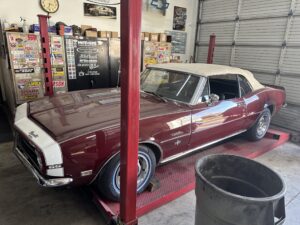
This 1967 Chevrolet Camaro VIN Verification was done by our team member in Tustin, Ca. on 1-17-2025

This 1967 Chevrolet Camaro VIN Verification was done by our team member in Tustin, Ca. on 1-17-2025
The 1967 Chevrolet Camaro introduced a new era for muscle cars, establishing itself as one of the most iconic vehicles of its time. As Chevrolet’s response to the success of Ford’s Mustang, the Camaro offered a fresh, powerful alternative. With its sleek design, robust engine options, and performance-oriented features, the 1967 Camaro quickly captured the attention of American car enthusiasts, becoming a hallmark of the muscle car era.
Introduced in 1966 for the 1967 model year, the Chevrolet Camaro was designed to compete with the Ford Mustang, which had already dominated the pony car market. General Motors had previously hesitated to enter this segment, but with the Mustang’s success, they saw a growing demand for a high-performance, stylish car. Built on the F-body platform, the Camaro offered various body styles, trim levels, and engine options, making it an immediate hit. The Camaro’s arrival signaled a new chapter in Chevrolet’s performance car lineage and became a significant player in the American muscle car landscape.
The 1967 Camaro offered a wide range of engine options, making it versatile for different levels of performance. Engine choices included:
Transmission options ranged from a three-speed manual to a four-speed manual and a two-speed Powerglide automatic, making the Camaro adaptable to various driving preferences.
The 1967 Camaro featured a bold, aggressive design that became synonymous with the muscle car era. Its long hood and short rear deck created a dynamic and athletic profile, while its wide grille and angular headlights ensured a commanding presence on the road. Inside, the Camaro was designed with performance in mind, offering bucket seats, a driver-oriented dashboard, and a functional center console. The Camaro was available in both coupe and convertible body styles, allowing buyers to choose the configuration that best suited their tastes.
The 1967 Camaro was offered in several distinct trims and variants to appeal to a broad range of buyers:
The 1967 Camaro offered basic safety features for its time. Standard safety equipment included front lap seat belts, with shoulder belts available as an option. While the car wasn’t equipped with modern safety features, its sturdy construction provided a degree of protection for the driver and passengers. The Camaro was more focused on performance, offering upgrades like power brakes, power steering, and improved suspension for better handling. The technology in the Camaro was geared toward enhancing the driving experience rather than convenience or luxury.
Fuel economy in the 1967 Camaro varied depending on the engine choice. The base 230-cubic inch inline-six engine provided the best fuel efficiency, with an estimated range of 18-22 mpg on the highway. However, the more powerful V8 engines, particularly the 396-cubic inch V8 in the SS model, offered much lower fuel economy, averaging around 12-15 mpg. Given the Camaro’s focus on performance, fuel efficiency was secondary, and buyers were more interested in the car’s power and driving experience.
Upon its release, the 1967 Camaro was positioned to take on the Ford Mustang, which was already the top contender in the pony car segment. The Camaro offered a wider range of engine options and a more aggressive design, making it a strong alternative to the Mustang. Other competitors included the Pontiac Firebird, which shared the same F-body platform, as well as the Mercury Cougar and Plymouth Barracuda. While the Mustang was well-established, the Camaro distinguished itself through its powerful engine choices, better handling, and distinctive style, capturing a loyal following.
The 1967 Chevrolet Camaro had a starting price of around $2,466 for the base model with the inline-six engine. Prices increased depending on the trim level and options selected, with the SS and Z/28 models being more expensive due to their high-performance features. The Camaro’s pricing was competitive with other muscle cars of the era, providing excellent value for the performance and customization options offered.
Although the 1967 Camaro did not win major formal awards in its initial years, it received significant praise for its performance, design, and overall impact on the muscle car market. The Camaro quickly became a favorite among enthusiasts and established itself as a key player in the American automotive industry. Its combination of power, style, and affordability made it a standout in its class, and it remains a beloved classic among collectors and muscle car aficionados today.
Need a VIN Verification? We are licensed to complete the REG 31 form. Call to get your car, truck or motorcycle verified today!
© 2025 QUICK VIN VERIFICATION. All rights reserved.